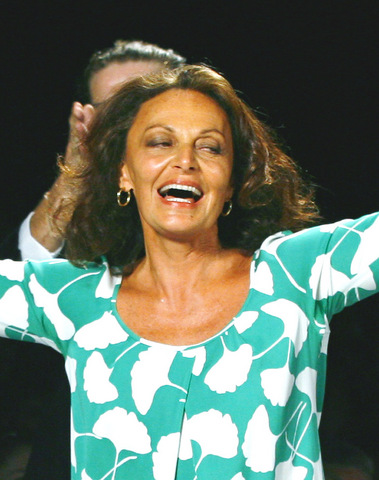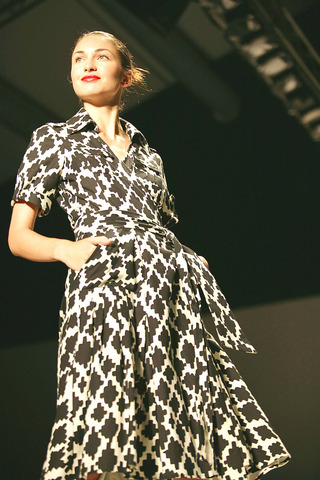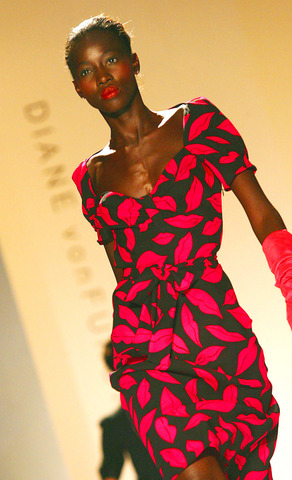Diane von Furstenberg once said her wrap dress was successful because it worked for women who loved clothes but still wanted to get stuff done. In a scrapbook, she has a page of newspaper clippings of famous women wearing the wrap dress in one year, 1976: it includes Gloria Steinem, Betty Ford, Julie Nixon Eisenhower, the actress Dina Merrill and Maureen Dean, the Watergate lawyer.
Today Von Furstenberg is wearing one of her own wrap dresses, with her glasses tucked into the V-neck. And she certainly has plenty of stuff to get done. There is one week to go until her catwalk show in New York, but she is in Paris in her role as president of the Council of Fashion Designers of America, for what she calls a "summit" with Hilary Riva of the British Fashion Council and representatives of the French and Italian fashion governing bodies, to discuss the issue of too-thin models. With the fashion show season about to begin again amid widespread unease about designers' use of skinny models, Von Furstenberg — who once commented wryly that "it will probably be on my tombstone: Here Lies the Woman Who Designed the Wrap Dress" — has what could be her best chance to alter that destiny. Being comfortable in the spotlight, she is a natural choice for an industry spokesperson. Today, in the elegant Left Bank apartment that she bought while living in the city in the 1980s, the sofas to which she guides us for our chat are situated directly beneath two large Andy Warhol portraits of the designer as a young woman.
It is already clear none of the Big Four fashion cities represented at her "summit" — New York, Paris, London or Milan — intend to follow the lead set by Madrid last season and ban skinny models from Manhattan. The Madrid ruling forbade the use of models with a body mass index of less than 18, meaning a 1.71m model would have to weigh a minimum of 54kgs to be allowed on a catwalk. Von Furstenberg is adamant that "what we need are guidelines, not rules. We need to encourage designers and agencies to be responsible. We need to make sure everyone is sensitive to the issues. But to calculate the girls' body mass — I personally think it is demeaning. I'm all about empowering women. And by lining them up against the wall and weighing them, surely you are making them feel more like meat than ever — even if it's little meat, if you know what I mean."

PHOTO: AGENCIES
There is, she says, "total agreement" between the US, British, French and Italian industries that the issue is best addressed without legislation. On Monday, the day after her show, Von Furstenberg will host a discussion panel in New York on thin models, health and body image. A nutritionist, a trainer, a model's agent and a specialist on eating disorders will speak. "As the president of the Council of Fashion Designers of America, I represent the designers. And while we can by no means take the blame for eating disorders, we can play our part in addressing this important issue." The one point on which she does intend to lay down rules is age: 14 year-olds and 15 year-olds are not uncommon on the catwalk and many feel these are often the girls most vulnerable to eating disorders. She intends to stipulate that none under 16 should appear in New York.
Von Furstenberg believes things are already improving. "I think it's great this issue has been raised. Fantastic, in fact. It's pushed a lot of people into becoming more sensitive to it. And just by being sensitive, we can improve a lot."
What does she think triggered the uproar? Are models really getting thinner? "No. I absolutely don't think they are. Twiggy was skinnier than everyone. When Jerry Hall did her first show for me, at 17, she was unbelievably narrow. The thing is, women are getting much bigger. A dress size that in the 1970s was a 12 is now a 6. So when we talk about a size zero — a few years ago, a dress that is now labeled size zero would have been labeled size 4. When I cast girls for my show, which I will be doing again in a few days, I don't see many girls who are very skinny. My samples are a size 4/6 and I don't have to adjust them to fit the catwalk girls."

But a lot of designers do use very thin models, I point out. "Do they?" she asks. Like many people who are naturally very direct, she is not particularly convincing when being disingenuous. Well, for instance, I say, at Giorgio Armani's show this week, the models were definitely bony. She gives me a look to say, you know perfectly well I'm not going to be drawn into that one. There is a pause, and eventually she says "personally ... I have always been attracted to clothes designed by women. Coco Chanel, Vionnet, Norma Kamali, Donna Karan. They have a little more — how do I put it? — understanding."
An official minimum weight would, she feels, only perpetuate the "absurd" notion of models as a physical ideal. "Most of the successful catwalk models are not very beautiful when you see them in real life. They are often quite odd-looking." Legislation about models' weight or body mass would, she thinks, feed the modern world's obsession with models, an obsession she finds ridiculous. "Modeling is a very strange and very short career. What's much more exciting and inspiring to me is that today we have a woman candidate for the presidency in France, and in the US we have a woman candidate for the presidency and a woman as Speaker of the House. Those are the things that young women should be inspired by and take confidence from."
Nonetheless, perhaps because she herself found youth and beauty no barrier to early success, she sees no contradiction in being a feminist who believes in the importance of looking good. (I recall seeing her in her New York show room once, adjusting the belt on a wrap dress: "You've got to pull it really tight," she kept saying. "See, now it's much more sexy!") She has always believed that "to look great you need a great body. I'm totally in favor of practicing yoga and climbing the stairs and eating healthy food ... . Oh, come on! It's true."

Feminine strength of will is a theme that runs through her memoir, Diane: A Signature Life. Her mother, Lily, was a survivor of Auschwitz-Birkenau and Ravensbruck concentration camps. She was 21 and weighed just 22kgs when Allied troops liberated the camps in 1945. Within six months she was married, and gave birth to Diane on New Year's Eve, 1946. "The Holocaust has shaped my character, Diane says. "I was born the daughter of a survivor, not a victim."
Von Furstenberg's extraordinary life has imbued her with a breezy attitude to achieving dreams. In her book, she recalls how as a girl, she and her friend Mireille would "play princesses." Later, the game became reality "when Mireille eloped at 17 with Prince Christian von Hannover, grandson of the Kaiser, and I married a German prince whose title dates from the Holy Roman Empire."
Having married and had children young, Von Furstenberg found her career taking off just as her marriage was falling apart. In 1976, the combined retail sales from her clothes, licenses, fragrance and cosmetic lines was US$117 million, she had made the cover of Newsweek and the front page of the Wall Street Journal. She was 29. It is perhaps a consequence of having achieved so much so young, and maybe due also to the example set by a mother who "rarely flattered me and never cautioned me," that she sees her role as being to inspire young women rather than protect them.

One of my favorite stories about Von Furstenberg is how she bought herself Cloudwalk, a farm in Connecticut, for her 27th birthday. If you do that to mark turning 27, how do you mark your 60th birthday, which she celebrated a month ago? It turns out she was rather rattled by the prospect. "Catherine Deneuve told me once she had thought she was prepared for turning 60, then when it happened it was really horrible. I never forgot that. So it was a big issue for me right up to the day itself. And then I was absolutely fine." And she smiles, and pulls her wrap dress a little tighter.


That US assistance was a model for Taiwan’s spectacular development success was early recognized by policymakers and analysts. In a report to the US Congress for the fiscal year 1962, former President John F. Kennedy noted Taiwan’s “rapid economic growth,” was “producing a substantial net gain in living.” Kennedy had a stake in Taiwan’s achievements and the US’ official development assistance (ODA) in general: In September 1961, his entreaty to make the 1960s a “decade of development,” and an accompanying proposal for dedicated legislation to this end, had been formalized by congressional passage of the Foreign Assistance Act. Two

Despite the intense sunshine, we were hardly breaking a sweat as we cruised along the flat, dedicated bike lane, well protected from the heat by a canopy of trees. The electric assist on the bikes likely made a difference, too. Far removed from the bustle and noise of the Taichung traffic, we admired the serene rural scenery, making our way over rivers, alongside rice paddies and through pear orchards. Our route for the day covered two bike paths that connect in Fengyuan District (豐原) and are best done together. The Hou-Feng Bike Path (后豐鐵馬道) runs southward from Houli District (后里) while the

March 31 to April 6 On May 13, 1950, National Taiwan University Hospital otolaryngologist Su You-peng (蘇友鵬) was summoned to the director’s office. He thought someone had complained about him practicing the violin at night, but when he entered the room, he knew something was terribly wrong. He saw several burly men who appeared to be government secret agents, and three other resident doctors: internist Hsu Chiang (許強), dermatologist Hu Pao-chen (胡寶珍) and ophthalmologist Hu Hsin-lin (胡鑫麟). They were handcuffed, herded onto two jeeps and taken to the Secrecy Bureau (保密局) for questioning. Su was still in his doctor’s robes at

Mirror mirror on the wall, what’s the fairest Disney live-action remake of them all? Wait, mirror. Hold on a second. Maybe choosing from the likes of Alice in Wonderland (2010), Mulan (2020) and The Lion King (2019) isn’t such a good idea. Mirror, on second thought, what’s on Netflix? Even the most devoted fans would have to acknowledge that these have not been the most illustrious illustrations of Disney magic. At their best (Pete’s Dragon? Cinderella?) they breathe life into old classics that could use a little updating. At their worst, well, blue Will Smith. Given the rapacious rate of remakes in modern